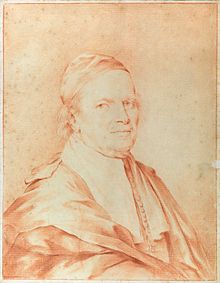Carlo Cignani
Carlo Cignani | |
|---|---|
 Self-portrait | |
| Born | 15 May 1628, Bologna |
| Died | 8 September 1719 (aged 91), Forlì |
| Nationality | Italian |
| Known for | Painting |
| Movement | Baroque |
Carlo Cignani (Italian pronunciation:
Life
He was born to a family of noble ancestry, but limited resources, in Bologna. His father's first name was Pompeo, and his mother, Maddalena Quaini.[2]

In Bologna, he studied first under Battista Cairo[3] and later under Francesco Albani, to whom he remained closely allied, and was his most famous disciple.[4] His first noted commission was a St Paul exorcising demon for the church of the Gesu in Bologna. For a hall dedicated to the Farnese in the Palazzo Publico, he painted with Taruffi, depicting the Francis, king of France, curing Scrofula on his entry to Bologna and the Entry of Paul III Farnese to Bologna'.[5]
He was also strongly influenced by the genius of
In 1681 Cignani returned to Bologna from Parma. He opened an accademia del nudo for painting from models and had as one of his pupils
He had some of the defects of his masters: his elaborate finish and his audacious artificiality in the use of color and in composition mark Albani's influence. Despite that, he imparted to his work more of an intellectual character than his mentors. As a man Cignani was eminently amiable, unassuming and generous.[4]

He accepted no honors offered him by the
His son
Selected works
- Penitent Magdalen, Dulwich Picture Gallery [1]
- Gemäldegalerie, Dresden
- Joseph and Potiphar's Wife, Musee Fesch, Ajaccio [2] Archived 2009-01-23 at the Wayback Machine
- Charity Oil on canvas, 119.4 x 161.3 cm, San Francisco Museum of Art[3]
- I piaceri della vita in campagna [4]
- Judgement of Paris (1691), Oil on canvas, 130.5 x 161 cm, [5]
- Aurora, Circolo della Scranna, Forlì [6]
- Incoronazione di Santa Rosa (Coronation of Saint Rose of Lima), Oil on canvas, Forlì, Pinacoteca Civica
- Self-portrait, Oil on canvas, Forlì, Pinacoteca Civica
- With Felice Cignani, La Vergine e San Filippo Neri (The Virgin and Saint Philip Neri), Oil on canvas, Forlì, Pinacoteca Civica.
Gallery
-
Madonna and Child, circa 1680
-
The Finding of Moses, Museum of Fine Arts of Nancy
-
Saint John and the Lamb
-
Penitent Magdalen, circa 1685–90
References
- ^ Dwight C. Miller. "Cignani, Carlo." Grove Art Online. Oxford Art Online. Oxford University Press. Web. 25 Dec. 2016
- ^ Zanelli, page 3-4.
- ^ Possibly, Giovanni Battista Cairo, father of Francesco Cairo.
- ^ a b c d One or more of the preceding sentences incorporates text from a publication now in the public domain: Chisholm, Hugh, ed. (1911). "Cignani, Carlo". Encyclopædia Britannica. Vol. 6 (11th ed.). Cambridge University Press. pp. 364–365.
- ^ Zanelli, page 9.
- ^ *Hobbes, James R. (1849). Picture collector's manual adapted to the professional man, and the amateur. London: T&W Boone. pp. 51–52.
- ^ Dizionario degli architetti, scultori, pittori, intagliatori d'ogni By Stefano Ticozzi, page 449, 1832
External links
 Media related to Carlo Cignani at Wikimedia Commons
Media related to Carlo Cignani at Wikimedia Commons- Spike, John T. (1986). Centro Di (ed.). Giuseppe Maria Crespi and the Emergence of Genre Painting in Italy. Fort Worth: Kimball Museum of Art. pp. 14–15.
- Ippolito, Zanelli (1722). Vita del Gran Pittore Cavalier Carlo Cignani. Bologna: Nella Stamperia di L. dalla Volpe.
 St John in the Wilderness., and engraving by William Ensom for The Easter Gift, 1832, with a poetical illustration by Letitia Elizabeth Landon
St John in the Wilderness., and engraving by William Ensom for The Easter Gift, 1832, with a poetical illustration by Letitia Elizabeth Landon





